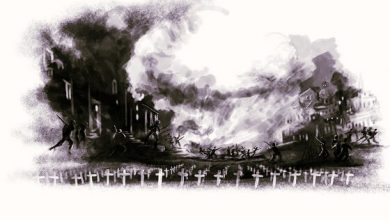
The Steadfast Tin Soldier, also known as The Brave Tin Soldier is a beautiful short story, written primarily for children, by Hans Christian Anderson, the popular Danish writer who is best known for his fairy tales like The Little Mermaid, The Ugly Duckling and The Little Match Girl. First published in 1838 in the first booklet of “Fairy Tales Told for Children. New Collection”, this story narrates the tale of a tin soldier’s love and devotion towards a paper ballerina and how, in spite of numerous hurdles put in his way by fate, he does not give up on his love and remains committed to her until his last breath.
The tin soldier is in no way a knight in shining armor- he only has one leg, he is unable to speak which is the major cause of his sufferings and he shows a blind acceptance to fate, without trying to change the destiny even once. But despite all this, what makes him the hero is his steadfast, unwavering and true love towards the one he had set his heart on and how, even after facing multiple obstacles in his path of love, he never once thinks of giving up. The theme of unrequited love, hardship, bravery, fragility, perseverance and he role of fate is found interspersed across the story.
The Steadfast Tin Soldier | Summary
The story begins with the description of the tin soldiers received by a little boy on his birthday. Made out of the same tin spoon, all the twenty-five soldiers presented a royal picture as they stood straight in their splendid red and blue uniform. One amongst them was slightly different from the rest as being made at the very end, there was not enough metal left for him and hence, he had only one leg.
This one-legged soldier, as he looked around and saw all the other things, saw among those playthings a beautiful paper ballerina who had one of her legs raised so high that it appeared as if she too had only one leg. Finding her to be as “different” as him, he instantly fell in love with her and decided at that very moment that he wanted to spend the rest of his life with her by his side. As he tried to figure out a way to make acquaintance with her, out of the snuff-box emerged a little black goblin who warned the soldier and asked him to stop desiring what did not belong to him, namely, the ballerina who was way beyond his reach, but the soldier, mesmerized and bewitched in his love, paid no heed.
The next morning, the children after playing with the tin soldiers left the one-legged soldier in the window from where due to the wind, or as he believed, the goblin’s doing, he fell out into the street. Even though the little boy went to look out for him, he could not find him and the soldier too, in his pride, did not speak up and let his location be known to those searching for him.
Soon it started to rain, and some children who happened to pass by, found him and decided to make a paper boat for him to sail in. As they set him down in the gutter to sail, the soldier wondered anxiously as to what awaits him next, with only the thought of his beloved giving him courage. As he sailed across the drain, he encountered many hurdles such as the rat that chased him for crossing the tunnel without paying the toll and the dangerous force of the stream. Through all these perils, what kept him going was the dancer, the love of his life, and fuelled by his desire to see her, he kept going, facing all dangers unflinchingly.
At one point, his boat fell into little pieces due to the force of the current and he sank into the deep waters where he was swallowed up by a big fish. As luck would have it, he found himself back in the same room from where he had fallen as the fish, after being caught was sold to the cook of that house and as she cut the fish, the soldier was discovered and placed on the table from where, on seeing his beloved, he was overwhelmed by emotions. But alas! This was just the beginning of the soldier’s sufferings. Soon enough, one of the little boys picked him up and threw him into the burning stove, the heat from which caused him great pain. Added to this was the fire of love burning within his heart which added to his agony and sorrow of not being able to express his feelings to the dancer even once. As the soldier melted away, bearing it all with pride, he looked at the lady and she looked back at him and lo behold! The dancer too was thrown into the stove by a draught of wind, where she burned into ashes just by his side. Thus, though not together during their life, these lovers were united by death. The next morning, the sweeper found within the ashes a little tin heart and the tinsel rose of the dancer, which was all that remained of them. Their love, strengthened by the soldier’s steadfastness, survived even the worst of all tragedies, acting as a proof of the power of love and loyalty.
The Steadfast Tin Soldier | Analysis
The most striking thing about this story is that unlike other fairy tales, this one doesn’t have a happy ending- both the protagonists suffer the pain of separation and ultimately a tragic death as the story comes to an end, instead of a happily ever after. Their love remains unfulfilled till the very end. The theme of unrequited love also makes its presence felt in the story. This is an especially important factor when one considers Hans Christian Andersen’s personal life and a series of infatuations he suffered, none of which were reciprocated.
The theme of one’s self-image may also be seen in the one-legged tin soldier who mistakes the ballerina to have a similar physical condition. Anderson in hi personal life did not have a flattering image about himself and while an auto biographical reading of a text isn’t among the best ways to examine it, one has to make an exception in Anderson’s case, as many of his fairy tales bear a recurrent link to his own personal life. This may also be seen in stories like The Little Match Girl, the summary and analysis of which may be read here.
The theme of uncertainty and unpredictability of life is seen in the series of misfortunes that befall brave tin soldier. From being blown away to the wind, to put in a paper boat, to being chased by the rat to being swallowed by a fish, to finally being melted in the fire – the tin soldier doesn’t see it coming. Yet he suffers it all, thanks to his love for the ballerina. Notice the symbolic role played by the gust of wind, which like the unpredictability of life takes him away from his love on the one hand, yet brings his love to him as the paper ballerina is blown into the fireplace.
Yet, despite not having a happy end, the story does not leave us with a sense of gloom and tragedy. Rather, it is a warm and emotional love story that evokes hope and faith in our hearts by showing us love in its most pristine form.
The plight and difficulties faced by the brave tin soldier as he falls in love with the beautiful ballerina who is far above his status, is representative of the hardships suffered by those who are considered “different” by the society. Even today, people who are unconventional are not accepted easily, and their passion is often disregarded. Everyone, even fate, works against them as they strive for their dreams and desires. Probably, by expressing the pain and agony of the tin soldier, Anderson seeks to inspire children to make the society more inclusive and considerate of all and hopes for a better future where no one, regardless of their physical, financial or social status, faces any obstruction in the pursuit of their dreams.


